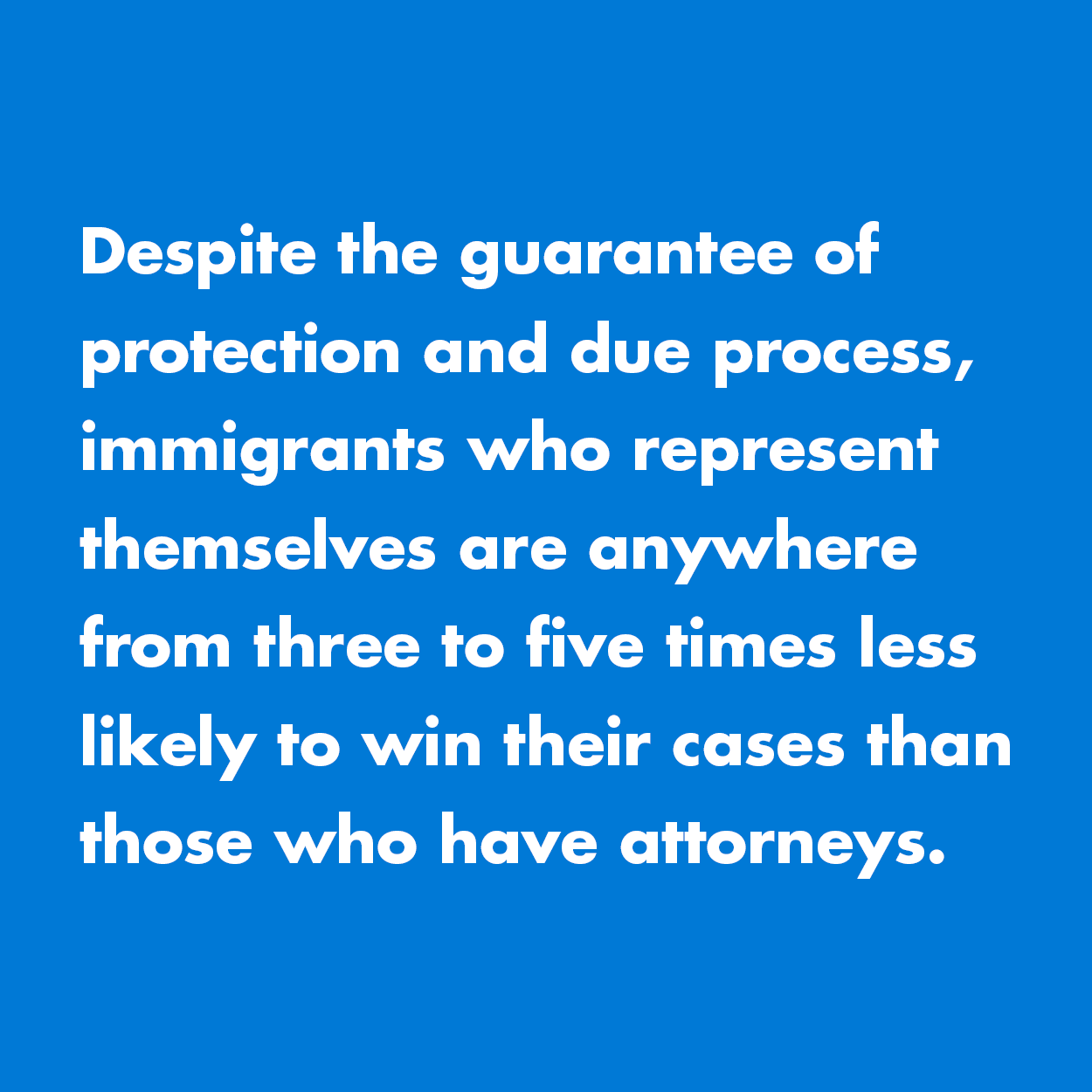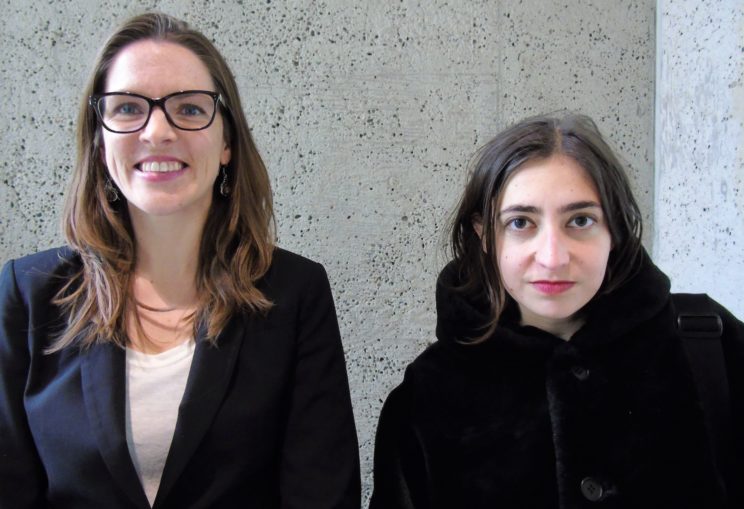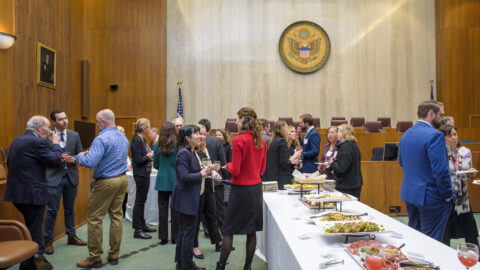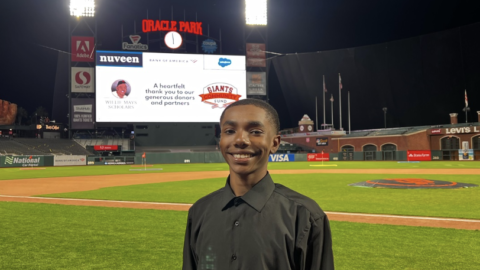A Day in the life of JDC’s Attorney of the Day Coordinator
A woman in her forties arrives in the lobby of the San Francisco Immigration Court with her six children in tow, all of whom are under the age of twelve. She rose early to get them all up, dressed, and out of the door because she lives about 2.5 hours away. All are required to appear for court. They wait in a long line before passing one-by-one through security. The security guard directs the woman to a courtroom where she takes a seat and tries to keep her children quiet. This is when I first notice the woman and her children.
I am a representative of the Attorney of the Day (AOD) program of the Justice & Diversity Center. I explain to her that I am an attorney and, for that day only, will consult with her and each one of the unrepresented immigrants in that courtroom and help them before the judge.
She follows me into a small office where I explain to her that I am not from the government but am there as part of a volunteer program. My intention is to help her understand her immigration options and help her before the judge. I explain that, in this initial hearing, the judge simply wants to know that she and her children are present and will ask for very basic information. When I ask to see her papers, she hands me a billfold which she has organized very carefully.
 I find her “Notice To Appear”, which is entirely in English (even though she speaks only Spanish), and I explain to her that it is the document where the government alleges why it believes she should be removed. I tell her that she will be given some initial hearings (such as this one) before the judge will want her to submit an application for an immigration benefit with evidence that she qualifies. When I ask the woman why she entered the U.S., she shows me her brother’s death certificate and explains that the cartel kidnapped her and two brothers before killing one of them in front of her. She is justifiably afraid that the cartel will murder her and her children. Based on her story, I explain to her that she might be eligible for asylum. This is possibly for the first time she’s heard this.
I find her “Notice To Appear”, which is entirely in English (even though she speaks only Spanish), and I explain to her that it is the document where the government alleges why it believes she should be removed. I tell her that she will be given some initial hearings (such as this one) before the judge will want her to submit an application for an immigration benefit with evidence that she qualifies. When I ask the woman why she entered the U.S., she shows me her brother’s death certificate and explains that the cartel kidnapped her and two brothers before killing one of them in front of her. She is justifiably afraid that the cartel will murder her and her children. Based on her story, I explain to her that she might be eligible for asylum. This is possibly for the first time she’s heard this.
I fill out the most basic information on the asylum form and tell the woman to get it stamped by the court clerk to initiate the asylum process. I explain that she has a right to an attorney, but the government will not pay for it. I then give her a list of nonprofits she can call to try to seek an attorney, but many of them have too many clients and are no longer accepting cases. After I give her a few additional pieces of advice, we go back to the courtroom.
We sit at a table on the right side of the room. The judge sits in front of us and a Department of Homeland Security (DHS) attorney, who will serve as a prosecutor throughout her case, is on our left. That day, the judge simply verifies the woman and her children’s presence and biographic information. The judge sets her next hearing for six weeks later to allow her time to find counsel. Her case is expedited under a new policy, so it is likely the judge will begin the substantive portion of the case at the next hearing.
International and federal law requires the U.S. to protect immigrants who cannot return to their home countries “owing to well-founded fear of being persecuted for reasons of race, religion, nationality, membership of a particular social group or political opinion”[1]. The 14th Amendment of the U.S. constitution states: “no state may deprive any person of life, liberty, or property, without due process of law.”[2]
 Without legal representation, this woman will be expected to read, understand, and submit a 12-page asylum application (all in her non-native English), which ideally should be accompanied by a brief, declarations, witness statements, and country conditions information. If she represents herself in court during her final hearing, she will not only testify but also be subject to cross-examination.
Without legal representation, this woman will be expected to read, understand, and submit a 12-page asylum application (all in her non-native English), which ideally should be accompanied by a brief, declarations, witness statements, and country conditions information. If she represents herself in court during her final hearing, she will not only testify but also be subject to cross-examination.
Despite the guarantee of protection and due process, immigrants who represent themselves are anywhere from three to five times less likely to win their cases than those who have attorneys.[3] Therefore, I was relieved when a local nonprofit agreed to represent this woman after I sent them a summary about her case.
The Justice & Diversity Center’s Attorney of the Day program offers what for many people may be their only opportunity to have a lawyer by their side before the Immigration Court judge. This particular case is just one example of how our program fills a critical gap and preserves immigrants’ rights.
We hope to expand our program to help more immigrants by advancing a policy of appointing an attorney to represent every immigrant facing removal proceedings. We encourage you to donate to the Justice & Diversity Center so that we can continue this important work.
About the authors:
 Claire Fawcett is the Attorney Coordinator for JDC’s Attorney of the Day (AOD) program and represents the AOD program at the San Francisco Immigration Court for the detained and non-detained dockets. Claire also supports the AOD program by recruiting and training attorney volunteers, and providing follow-up legal assistance to pro se respondents. Previously, Claire worked as a staff attorney for Immigration Center for Women and Children and Centro Legal de la Raza where she represented low-income immigrants in their cases before immigration agencies and the immigration court. Claire received her B.A. from Haverford College and her J.D. from Northeastern Law School. She is barred in California and is fluent in Spanish.
Claire Fawcett is the Attorney Coordinator for JDC’s Attorney of the Day (AOD) program and represents the AOD program at the San Francisco Immigration Court for the detained and non-detained dockets. Claire also supports the AOD program by recruiting and training attorney volunteers, and providing follow-up legal assistance to pro se respondents. Previously, Claire worked as a staff attorney for Immigration Center for Women and Children and Centro Legal de la Raza where she represented low-income immigrants in their cases before immigration agencies and the immigration court. Claire received her B.A. from Haverford College and her J.D. from Northeastern Law School. She is barred in California and is fluent in Spanish.
 Nicole Allen is the SFILDC Immigration Legal Services Coordinator. She supports the SFILDC by coordinating intakes and referrals among the collaborative partners, and connecting San Francisco residents to legal resources and information. She also calendars volunteer attorneys for the Attorney of the Day Program at the San Francisco Immigration Court for the non-detained adult and juvenile dockets, develops and distributes informational materials at the court, and serves as a Spanish interpreter for AODs. Nicole also collects and analyzes data from these programs. Nicole received her undergraduate degree at the University of California, Berkeley in Philosophy with a special interest in ethics and logic. Nicole is fluent in Spanish.
Nicole Allen is the SFILDC Immigration Legal Services Coordinator. She supports the SFILDC by coordinating intakes and referrals among the collaborative partners, and connecting San Francisco residents to legal resources and information. She also calendars volunteer attorneys for the Attorney of the Day Program at the San Francisco Immigration Court for the non-detained adult and juvenile dockets, develops and distributes informational materials at the court, and serves as a Spanish interpreter for AODs. Nicole also collects and analyzes data from these programs. Nicole received her undergraduate degree at the University of California, Berkeley in Philosophy with a special interest in ethics and logic. Nicole is fluent in Spanish.
[1] As defined in the UN Convention and Protocol Relating to the Status of Refugees of 1951. Worth noting the original definition included temporal and spatial restrictions that were removed in The Protocol of 1967.
[2] Amendment XIV, U.S. Constitution, available at: https://www.law.cornell.edu/constitution/amendmentxiv
[3]Eagly, Ingrid and Steven Shafer, “Access to Counsel in Immigration Court,” American Immigration Counsel (September 2016), available at: https://www.americanimmigrationcouncil.org/sites/default/files/research/access_to_counsel_in_immigration_court.pdf at 15.




